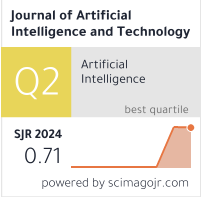Conductivity Prediction Method of Solid Electrolyte Materials Based on Pearson Coefficient Method and Ensemble Learning
DOI:
https://doi.org/10.37965/jait.2024.0551Keywords:
ionic conductivity, logistic regression algorithm, Pearson correlation coefficient, random forest regression, solid electrolyte materialAbstract
In order to screen solid electrolytic materials with high ionic conductivity more quickly and accurately, a conductivity prediction method for solid electrolyte materials based on logistic regression model and random forest regression model is constructed. The method first selects 20 characteristic descriptors related to ionic conductivity from material library according to four dimensions: structural stability, metal stability, electronic conductivity and oxidative decomposition stability. The enumeration method and feature selection method are used to combine different features. Then, the dimension reduction of the feature combinations is carried out by Pearson coefficient method, so as to screen the optimal feature combinations. Finally, according to the optimal feature combination and data subset, the constructed random forest ensemble learning model is utilized to predict the ionic conductivity of other solid-state electrolyte materials in the material library, in order to find the solid-state electrolyte materials that can meet the high conductivity. The results indicate that as the number of features in the combination increases, the prediction performance of the model shows a trend of first increasing and then decreasing. When the feature descriptor in the combination is 7, the maximum AUC (Accuracy) value is reached, and the optimal feature in this case contains 7 optimal feature subsets corresponding to feature descriptors, namely the standard deviation of the average adjacency number of Li atoms, the standard deviation of Li-X ion bonds, the average electronegativity of the straight path, the average width of the straight path, the average atomic volume, the average Li-Li bond, and the filling fraction of the sublattice. On the basis of the optimal feature screening, the average prediction accuracy of the logistic regression model is 87.13%, which has a high accuracy. Using the random forest regression model for prediction, the average absolute error and root mean square error obtained are only 0.237 and 0.134, and compared with classical classification methods such as KNN, SVM and Adaboost, they are smaller, which can better predict the ionic conductivity of solid electrolyte materials. This proves that the constructed method can quickly and accurately produce high ionic conductivity materials in solid electrolyte materials, which is worthy of further research and promotion.
Published
How to Cite
Issue
Section
License
Copyright (c) 2024 Authors

This work is licensed under a Creative Commons Attribution 4.0 International License.





